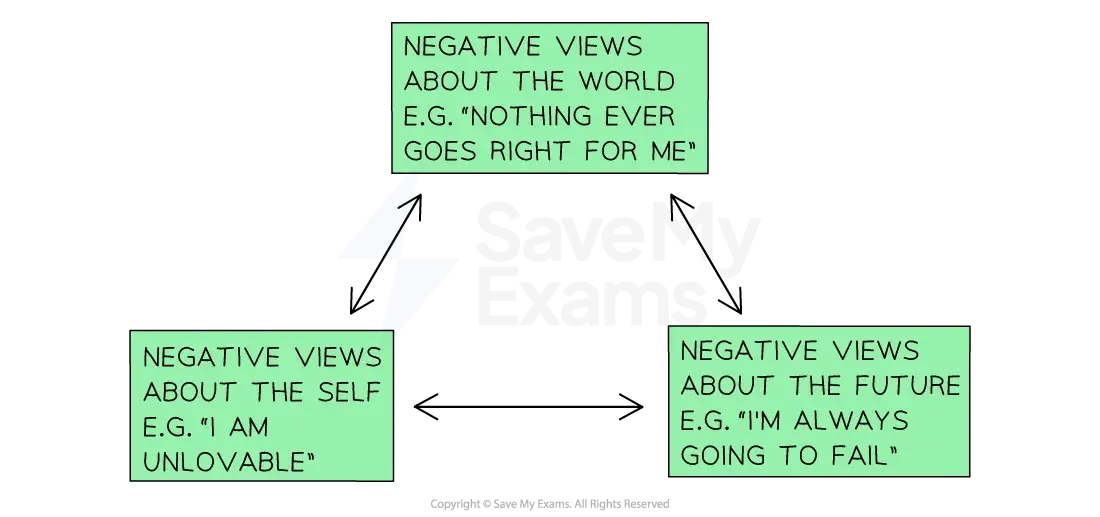Syllabus Edition
First teaching 2025
First exams 2027
CBT for Major Depressive Disorder (MDD) (DP IB Psychology): Revision Note
Beck's model: the negative triad
The cognitive approach explains behaviour through mental processes such as thinking, decision-making, memory, and perception
In relation to MDD, the approach assumes depression results from faulty or irrational thought processes, where depressed individuals rely too heavily on cognitive biases
The cognitive triad
Beck (1963) developed an explanation of MDD known as the cognitive triad, which was based on depressed patients he had worked with
The cognitive triad is divided into three patterns of negative thinking:
Negative view about the self, e.g., 'I'm worthless'
Negative view about the world, e.g., 'Nobody cares about me'
Negative views about the future, e.g., 'Things will never get better'

Features of depressed thinking
Beck suggested that the irrational thought patterns below may stem from adverse childhood experiences
Personalisation: irrationally blaming the world or events on oneself (e.g., 'Everyone hates me – even the bus hates me because it didn’t stop')
Negative automatic thoughts: always seeking out the negative in situations (e.g., 'A promotion just means more stress')
Catastrophising: expecting the worst possible outcome (e.g., 'A low mark in this essay means I’ll fail the IB and end up broke')
Overgeneralisations: applying one negative event to all situations (e.g., 'What a bad date – I’ll never find anyone')
Diathesis–stress model
Beck proposed a diathesis-stress component of his theory which states that some people are naturally predisposed to developing MDD
Environmental stressors (e.g., job loss) may trigger depression in vulnerable individuals, while others may not be affected in the same way
This means that MDD does not have universal triggers as one person's vulnerability is different to another person's and not all triggers are equal
CBT for MDD
Cognitive Behavioural Therapy (CBT) is the most widely used psychological treatment for depression and is a practical application of Beck’s cognitive theory
The focus is on the 'here-and-now' rather than the past
The goal is to help clients identify, challenge, and replace irrational thoughts (from Beck’s negative triad) with more adaptive thinking while building independence
Techniques used in CBT
Cognitive restructuring/reframing - turning negative thoughts into more positive ones
Guided discovery – the therapist challenges irrational thoughts and beliefs
Journaling – recording thoughts, feelings, and behaviours between sessions
Activity scheduling/behavioural activation – encouraging action, reducing procrastination
Relaxation techniques – deep breathing, muscle relaxation, visualisation
Role-playing – practising difficult or anxiety-provoking scenarios
Homework – e.g., recording positive events, which are then discussed in therapy
A course of CBT usually lasts 5–20 sessions, once a week or fortnight, each lasting 30–60 minutes
Research support for CBT for MDD
March et al. (2007)
Aim:
To compare the effectiveness of CBT, SSRIs (fluoxetine), and combined CBT and SSRIs for treating adolescents with MDD
Participants:
327 adolescents (aged 12–17) with diagnosed MDD from 13 US locations
Procedure:
The participants were randomly assigned to:
SSRI group
CBT group
Combined CBT and SSRI group
The children were interviewed, and their responses were measured using the Children’s Depression Rating Scale (CDRS)
A score of >40 meant that MDD was present
A score of <28 meant that they were in remission
The study ran for 36 weeks
Results:
After 36 weeks:
81% improved in the SSRI group
81% improved in CBT group
86% improved in the combination group
Suicidal ideation decreased in the CBT and combination groups, but not significantly in the SSRI-only group
Conclusion:
Adolescents respond well to CBT and to combined CBT and drug therapy
Combining therapies may enhance the safety of medication and be the most effective treatment option
Evaluation of CBT for MDD
Strengths
CBT is not a non-invasive therapy, as it involves no drugs or side effects, unlike biological treatments
CBT is individualised, as sessions can be tailored to the client, allowing them to progress at their own pace and accounting for individual differences
Limitations
The focus on the present may not be appropriate for people who need to revisit past trauma to recover
This limits the usefulness of the therapy, as it may not be effective for all
Some people struggle with 'talking therapies' like CBT due to lack of confidence, willingness, or verbal/intellectual skills, which also limits the usefulness of the therapy
Link to concepts
Measurement
The study presented above is longitudinal (conducted over a series of months), which means that progress can be assessed by measuring depression symptoms at specific points compared to the baseline measurements
The participants’ progress can only be properly assessed over time, which gives longitudinal research ecological validity (real behaviour measured in real time)
Bias
Participants in the study were self-reporting using a rating scale, which means that they may have succumbed to social desirability bias (under-reporting their symptoms) or practice effect (i.e., they became used to filling in the questionnaire, so that their answers became less natural over time)
The researchers would have to consider how to guard against these forms of bias to preserve the validity of the findings

Unlock more, it's free!
Did this page help you?